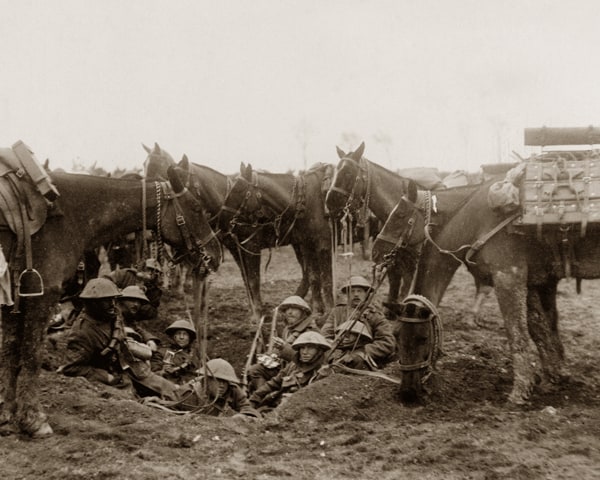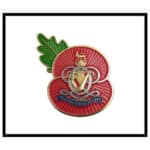An extract from the War Diary of the 4th Hussars, March 1918.
30th March
The Divisional Headquarters was at Boves.
The situation was very vague until we got to Windmill Hill. It was then found that the Canadian Brigade, under General Seely, had attacked and got a footing in Cavalry Wood just above Moreuil. General Bell-Smyth at once gave orders to the brigade, and the 4th Hussars were on the extreme right.
‘A’ Squadron, 4th Hussars, under Lieutenant G. Greville, was ordered to work down the western edge of the Bois de Moreuil, and to secure the right flank of the Canadians. This squadron got a footing on the ridge between Moreuil and the wood and sent patrols through Moreuil village to gain touch with the French.
Corporal Stapley and Lance-Corporal Sampson of ‘A’ Squadron, and Corporal Law of ‘B’ Squadron, all did excellent work here with their patrols. Moreuil was now being shelled by both sides. ‘A’ Squadron was in front of the general alignment on the left, and as a result, came under heavy machine-gun fire from the southwest corner of the wood; their led horses, too, were shelled by the French, who mistook them for Uhlan horses.
Several Hun horses were captured in Moreruil village. ‘A’ Squadron was forced to retire from the ridge they had been holding, but there was another about half a mile north, on which ‘B’ Squadron were, and who covered the retirement. Meanwhile ‘C’ Squadron under Captain Beaman, was ordered to work along the western edge of the wood. Having reached a track at I.3.b.6.4, they got in touch with the right of the Canadians.
They received verbal orders from General Seely to push on to the corner of the wood (i.e., the same comer from which the fire made ‘A’ Squadron withdraw). They met very heavy and accurate machine-gun and field-gun fire, and had to withdraw to the track. Squadrons of 5th and 16th Lancers and some men of the Warwicks reinforced the line in the wood, which was slightly advanced. Very heavy fighting went on all day, and the casualties were heavy.
The line was finally taken over by the 8th Infantry Division at 2.30 a.m. on the 31st, and the regiment withdrew to Thiennes. It had been pouring with rain all day.
Colonel Darley was riding his horse “Bill” when a shell pitched right under him; fortunately; it was a “dud.” Major Laing was saved by his steel helmet, a machine-gun bullet hitting it and denting it sufficiently to knock him out, and slightly wounding him; he, however, remained with the regiment.
During the day two machine guns of the 3rd Machine Gun Squadron were at the disposal of the C.O.; and ‘D’ Battery, R.H.A., under Major Norton, was also available, though no favourable targets appeared.
31st March
A fine day and a reasonably quiet morning. The horses were kept. saddled up, and we were ready to move instantly. At about 1 p.m. an urgent message came from General Bell-Smyth, ordering the regiment to gallop up to Windmill Hill and get into dismounted action, as the infantry of the 8th Division had been driven out of Moreuil Wood.
All three squadrons were dismounted, as the ground was quite unsuitable for any mounted action. Rapid-fire was at once opened, range 900 yards at the Germans, who were debouching from the western edge of the wood. This at once stopped them, and they could be seen running back to the wood or digging in in the open.
The Hotchkiss rifles did good work in silencing the enemy automatic weapons, and ‘D’ Battery did some very pretty execution at a good target. Later on, squadrons of the 5th and 16th Lancers came into the alignment.
Owing to the lie of the country, both ‘A’ and ‘C’ Squadrons had to go farther forward than ‘B’ Squadron to get their field of fire. In the evening the enemy captured Rifle Wood, on our left, and was able to bring enfilade machine-gun fire on ‘A’ and ‘C’ Squadrons, and heavy casualties were caused.
Colonel Darley was riding near the Brigadier when again a shell pitched right under his horse; unfortunately, it was not a “dud,” and the horse “Bill” and Colonel Darley were killed instantly. He was buried later at Thiennes. Major Laing then took over command of the regiment.
Having no entrenching tools on the men these had to be sent back for from the tool packs with the led horses, which were below Windmill Hill. Extra ammunition had also to be got up.
By nightfall, the casualties had become very heavy, but the remainder of the men dug themselves in well. The Hotchkiss gun numbers had very heavy losses. The squadrons remained in their positions all night. The horses were moved back about two miles to where they could water and get forage. The night passed off quietly.
The 4th Hussars suffered 3 Officers and 12 ORs killed and 2 Officers and 44 ORs wounded over these 2 days.
Gordon Muriel Flowerdew VC was an English-born Canadian recipient of the Victoria Cross, the highest and most prestigious award for gallantry in the face of the enemy that can be awarded to British and Commonwealth forces, received for his actions at the Battle of Moreuil Wood.



